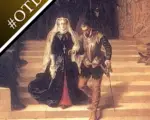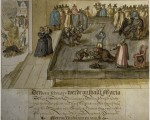
On this day in Tudor history, 8th February, Mary, Queen of Scots was executed in a rather botched beheading, and Elizabeth I’s favourite, Robert Devereux, 2nd Earl of Essex, launched a rebellion, which did not go well…
[Read More...]
On this day in Tudor history, 8th February, Mary, Queen of Scots was executed in a rather botched beheading, and Elizabeth I’s favourite, Robert Devereux, 2nd Earl of Essex, launched a rebellion, which did not go well…
[Read More...]
On this day in Tudor history, 7th February 1587, the warrant for the execution of Mary, Queen of Scots, arrived at Fotheringhay Castle in Northamptonshire, where Mary was being held.
Mary had been tried for treason in October 1586 after being implicated in the Babington Plot, a plot to depose Queen Elizabeth I and to replace her with Mary. She had been found guilty and sentenced to death, but Elizabeth would not sign the execution warrant, not wanting the responsibility of killing an anointed queen. However, Mary’s gaoler, Sir Amias Paulet, would not agree to quietly doing away with Mary, and after pressure from her council and petitions from Parliament, Elizabeth finally signed the warrant, although she later said she had asked for it not to be sent to Fotheringhay yet.
[Read More...]
In today’s Claire chats I continue my examination of the fall of Mary, Queen of Scots, by looking at the controversy surrounding the death warrant and examining the Bond of Association and the Act for the Queen’s Safety.
[Read More...]
On this day in history, Wednesday 8th February, Mary, Queen of Scots was executed at Fotheringhay Castle, following the arrival of her death warrant at the castle the day before.
Mary had been tried in October 1586 for her involvement in the Babington Plot, a plot to assassinate Queen Elizabeth I, and had been found guilty. Elizabeth I put off signing her death warrant, struggling with the idea of killing an anointed monarch, but finally signed the warrant on 1st February 1587, although Elizabeth claimed later that she ordered her secretary, William Davison, not to do anything with it for the time being. As I mentioned in my article on the death warrant, Elizabeth’s Privy Council met and agreed to send the warrant to Fotheringhay without the Queen’s knowledge. It is impossible to know exactly what happened. Did Davison misunderstand the Queen’s instructions and intentions? Probably not. Some historians believe that William Cecil, Lord Burghley, chose Davison to be a scapegoat because he realised that Elizabeth needed someone to take the responsibility for Mary’s death away from her, but others believe that it was Elizabeth who chose Davison as the scapegoat.
[Read More...]
This primary source account of the execution of Mary, Queen of Scots is from Original letters, illustrative of English history; with notes and illustrations, Second Series, Volume III, ed. Henry Ellis (p113-118). Ellis notes that “the present narrative is from the Lansdowne MS. 51. art. 46. It is indorsed in Lord Burghley’s hand, “8 Feb. 1586. The Manner of the Q. of Scotts death at Fodrynghay, wr. by Ro. Wy.””
[Read More...]